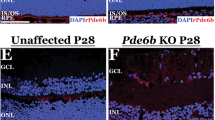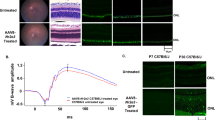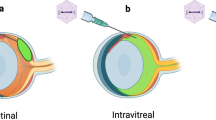Abstract
Aryl hydrocarbon receptor-interacting protein-like 1 (AIPL1) is required for the biosynthesis of photoreceptor phosphodiesterase (PDE). Gene defects in AIPL1 cause a heterogeneous set of conditions ranging from Leber's congenital amaurosis (LCA), the severest form of early-onset retinal degeneration, to milder forms such as retinitis pigmentosa (RP) and cone-rod dystrophy. In mice, null and hypomorphic alleles cause retinal degeneration similar to human LCA and RP, respectively. Thus these mouse models represent two ends of the disease spectrum associated with AIPL1 gene defects in humans. We evaluated whether adeno-associated virus (AAV)-mediated gene replacement therapy in these models could restore PDE biosynthesis in rods and cones and thereby improve photoreceptor survival. We validated the efficacy of human AIPL1 (isoform 1) replacement gene controlled by a promoter derived from the human rhodopsin kinase (RK) gene, which is active in both rods and cones. We found substantial and long-term rescue of the disease phenotype as a result of transgene expression. This is the first gene therapy study in which both rods and cones were targeted successfully with a single photoreceptor-specific promoter. We propose that the vector and construct design used in this study could serve as a prototype for a human clinical trial.
This is a preview of subscription content, access via your institution
Access options
Subscribe to this journal
Receive 12 print issues and online access
$259.00 per year
only $21.58 per issue
Buy this article
- Purchase on Springer Link
- Instant access to full article PDF
Prices may be subject to local taxes which are calculated during checkout








Similar content being viewed by others
References
Sohocki MM, Bowne SJ, Sullivan LS, Blackshaw S, Cepko CL, Payne AM et al. Mutations in a new photoreceptor-pineal gene on 17p cause Leber congenital amaurosis. Nat Genet 2000; 24: 79–83.
Ramamurthy V, Niemi GA, Reh TA, Hurley JB . Leber congenital amaurosis linked to AIPL1: a mouse model reveals destabilization of cGMP phosphodiesterase. Proc Natl Acad Sci USA 2004; 101: 13897–13902.
Liu X, Bulgakov OV, Wen XH, Woodruff ML, Pawlyk B, Yang J et al. AIPL1, the protein that is defective in Leber congenital amaurosis, is essential for the biosynthesis of retinal rod cGMP phosphodiesterase. Proc Natl Acad Sci USA 2004; 101: 13903–13908.
Sohocki MM, Perrault I, Leroy BP, Payne AM, Dharmaraj S, Bhattacharya SS et al. Prevalence of AIPL1 mutations in inherited retinal degenerative disease. Mol Genet Metab 2000; 70: 142–150.
Dharmaraj S, Leroy BP, Sohocki MM, Koenekoop RK, Perrault I, Anwar K et al. The phenotype of Leber congenital amaurosis in patients with AIPL1 mutations. Arch Ophthalmol 2004; 122: 1029–1037.
Dyer MA, Donovan SL, Zhang J, Gray J, Ortiz A, Tenney R et al. Retinal degeneration in Aipl1-deficient mice: a new genetic model of Leber congenital amaurosis. Brain Res Mol Brain Res 2004; 132: 208–220.
Khani SC, Pawlyk BS, Bulgakov OV, Kasperek E, Young JE, Adamian M et al. AAV-mediated expression targeting of rod and cone photoreceptors with a human rhodopsin kinase promoter. Invest Ophthalmol Vis Sci 2007; 48: 3954–3961.
Rivolta C, Sharon D, DeAngelis MM, Dryja TP . Retinitis pigmentosa and allied diseases: numerous diseases, genes, and inheritance patterns. Hum Mol Genet 2002; 11: 1219–1227.
Berson EL . Retinitis pigmentosa. The Friedenwald Lecture. Invest Ophthalmol Vis Sci 1993; 34: 1659–1676.
Koenekoop RK . An overview of Leber congenital amaurosis: a model to understand human retinal development. Surv Ophthalmol 2004; 49: 379–398.
Allikmets R, Koenekoop RK, Cremers FP, van den Hurk JA, den Hollander AI, Perrault I et al. Leber congenital amaurosis: a genetic paradigm. Ophthalmic Genet 2004; 25: 67–79.
Dryja TP, Adams SM, Grimsby JL, McGee TL, Hong DH, Li T et al. Null RPGRIP1 alleles in patients with Leber congenital amaurosis. Am J Hum Genet 2001; 68: 1295–1298.
Gerber S, Perrault I, Hanein S, Barbet F, Ducroq D, Ghazi I et al. Complete exon–intron structure of the RPGR-interacting protein (RPGRIP1) gene allows the identification of mutations underlying Leber congenital amaurosis. Eur J Hum Genet 2001; 9: 561–571.
den Hollander AI, Roepman R, Koenekoop RK, Cremers FP . Leber congenital amaurosis: genes, proteins and disease mechanisms. Prog Retin Eye Res 2008; 27: 391–419.
Akey DT, Zhu X, Dyer M, Li A, Sorensen A, Blackshaw S et al. The inherited blindness associated protein AIPL1 interacts with the cell cycle regulator protein NUB1. Hum Mol Genet 2002; 11: 2723–2733.
Ramamurthy V, Roberts M, van den Akker F, Niemi G, Reh TA, Hurley JB . AIPL1, a protein implicated in Leber's congenital amaurosis, interacts with and aids in processing of farnesylated proteins. Proc Natl Acad Sci USA 2003; 100: 12630–12635.
van der Spuy J, Cheetham ME . The Leber congenital amaurosis protein AIPL1 modulates the nuclear translocation of NUB1 and suppresses inclusion formation by NUB1 fragments. J Biol Chem 2004; 279: 48038–48047.
van der Spuy J, Chapple JP, Clark BJ, Luthert PJ, Sethi CS, Cheetham ME . The Leber congenital amaurosis gene product AIPL1 is localized exclusively in rod photoreceptors of the adult human retina. Hum Mol Genet 2002; 11: 823–831.
Snyder SH, Lai MM, Burnett PE . Immunophilins in the nervous system. Neuron 1998; 21: 283–294.
Young JC, Barral JM, Ulrich Hartl F . More than folding: localized functions of cytosolic chaperones. Trends Biochem Sci 2003; 28: 541–547.
Chapple JP, Grayson C, Hardcastle AJ, Saliba RS, van der Spuy J, Cheetham ME . Unfolding retinal dystrophies: a role for molecular chaperones? Trends Mol Med 2001; 7: 414–421.
Bulgakov OV, Liu X, Li T . The biosynthesis/transport of cone photoreceptor cGMP phosphodiesterases requires AIPLI, a putative chaperone protein that is defective in one form of Leber congenital amorosis. Invest Ophthalmol Vis Sci 2005; 46: Abstract 1728.
Lamb TD, Pugh Jr EN . A quantitative account of the activation steps involved in phototransduction in amphibian photoreceptors. J Physiol 1992; 449: 719–758.
Allocca M, Mussolino C, Garcia-Hoyos M, Sanges D, Iodice C, Petrillo M et al. Novel adeno-associated virus serotypes efficiently transduce murine photoreceptors. J Virol 2007; 81: 11372–11380.
Natkunarajah M, Trittibach P, McIntosh J, Duran Y, Barker SE, Smith AJ et al. Assessment of ocular transduction using single-stranded and self-complementary recombinant adeno-associated virus serotype 2/8. Gene Therapy 2008; 15: 463–467.
Ali RR, Reichel MB, Thrasher AJ, Levinsky RJ, Kinnon C, Kanuga N et al. Gene transfer into the mouse retina mediated by an adeno-associated viral vector. Hum Mol Genet 1996; 5: 591–594.
Bennett J, Maguire AM, Cideciyan AV, Schnell M, Glover E, Anand V et al. Stable transgene expression in rod photoreceptors after recombinant adeno-associated virus-mediated gene transfer to monkey retina. Proc Natl Acad Sci USA 1999; 96: 9920–9925.
Rabinowitz JE, Rolling F, Li C, Conrath H, Xiao W, Xiao X et al. Cross-packaging of a single adeno-associated virus (AAV) type 2 vector genome into multiple AAV serotypes enables transduction with broad specificity. J Virol 2002; 76: 791–801.
Ali RR . Prospects for gene therapy. Novartis Found Symp 2004; 255: 165–172; discussion 173–168.
Dejneka NS, Rex TS, Bennett J . Gene therapy and animal models for retinal disease. Dev Ophthalmol 2003; 37: 188–198.
Rolling F . Recombinant AAV-mediated gene transfer to the retina: gene therapy perspectives. Gene Therapy 2004; 11: S26–S32.
Ali RR, Sarra GM, Stephens C, Alwis MD, Bainbridge JW, Munro PM et al. Restoration of photoreceptor ultrastructure and function in retinal degeneration slow mice by gene therapy. Nat Genet 2000; 25: 306–310.
Acland GM, Aguirre GD, Ray J, Zhang Q, Aleman TS, Cideciyan AV et al. Gene therapy restores vision in a canine model of childhood blindness. Nat Genet 2001; 28: 92–95.
Dejneka NS, Surace EM, Aleman TS, Cideciyan AV, Lyubarsky A, Savchenko A et al. In utero gene therapy rescues vision in a murine model of congenital blindness. Mol Ther 2004; 9: 182–188.
Narfstrom K, Katz ML, Bragadottir R, Seeliger M, Boulanger A, Redmond TM et al. Functional and structural recovery of the retina after gene therapy in the RPE65 null mutation dog. Invest Ophthalmol Vis Sci 2003; 44: 1663–1672.
Smith AJ, Schlichtenbrede FC, Tschernutter M, Bainbridge JW, Thrasher AJ, Ali RR . AAV-mediated gene transfer slows photoreceptor loss in the RCS rat model of retinitis pigmentosa. Mol Ther 2003; 8: 188–195.
Pawlyk BS, Smith AJ, Buch PK, Adamian M, Hong DH, Sandberg MA et al. Gene replacement therapy rescues photoreceptor degeneration in a murine model of Leber congenital amaurosis lacking RPGRIP. Invest Ophthalmol Vis Sci 2005; 46: 3039–3045.
Pang JJ, Boye SL, Kumar A, Dinculescu A, Deng W, Li J et al. AAV-mediated gene therapy for retinal degeneration in the rd10 mouse containing a recessive PDEbeta mutation. Invest Ophthalmol Vis Sci 2008; 49: 4278–4283.
Alexander JJ, Umino Y, Everhart D, Chang B, Min SH, Li Q et al. Restoration of cone vision in a mouse model of achromatopsia. Nat Med 2007; 13: 685–687.
Tan MH, Smith AJ, Pawlyk B, Xu X, Liu X, Bainbridge JB et al. Gene therapy for retinitis pigmentosa and Leber congenital amaurosis caused by defects in AIPL1: effective rescue of mouse models of partial and complete Aipl1 deficiency using AAV2/2 and AAV2/8 vectors. Hum Mol Genet 2009; 18: 2099–2114.
Cideciyan AV, Aleman TS, Boye SL, Schwartz SB, Kaushal S, Roman AJ et al. Human gene therapy for RPE65 isomerase deficiency activates the retinoid cycle of vision but with slow rod kinetics. Proc Natl Acad Sci USA 2008; 105: 15112–15117.
Maguire AM, Simonelli F, Pierce EA, Pugh Jr EN, Mingozzi F, Bennicelli J et al. Safety and efficacy of gene transfer for Leber's congenital amaurosis. N Engl J Med 2008; 358: 2240–2248.
Bainbridge JW, Smith AJ, Barker SS, Robbie S, Henderson R, Balaggan K et al. Effect of gene therapy on visual function in Leber's congenital amaurosis. N Engl J Med 2008; 358: 2231–2239.
Young JE, Vogt T, Gross KW, Khani SC . A short, highly active photoreceptor-specific enhancer/promoter region upstream of the human rhodopsin kinase gene. Invest Ophthalmol Vis Sci 2003; 44: 4076–4085.
Young JE, Gross KW, Khani SC . Conserved structure and spatiotemporal function of the compact rhodopsin kinase (GRK1) enhancer/promoter. Mol Vis 2005; 11: 1041–1051.
Xiao X, Li J, Samulski RJ . Production of high-titer recombinant adeno-associated virus vectors in the absence of helper adenovirus. J Virol 1998; 72: 2224–2232.
Molday R . Monoclonal antibodies to rhodopsin and other proteins of rod outer segments. In: Osborne N, Chader G (eds). Progress in Retinal Research, vol. 8. Pergamon Press: New York, 1988, pp 173–209.
Acknowledgements
We thank Dr Michael Dyer (St Jude Children's Research Hospital, Memphis, TN, USA) for providing the Aipl1−/− mice, Dr Visvanathan Ramamurthy (West Virginia University, Morgantown, WV, SA) for human AIPL1 antiserum, Norman Michaud (Massachusetts Eye & Ear Histology Core) for a portion of the histology processing and Dr Jeng-Shin Lee (the Research Vector Core, Harvard Medical School) for AAV vector packaging. This work was supported by National Eye Institute Grant EY10581, NEI core grant for Vision Research (P30EY14104), the Foundation Fighting Blindness, the Foundation for Retina Research, the Macular Vision Research Foundation, the Massachusetts Lions Eye Research Fund and by grants from the European Union (AAVEYE), the UK Department of Health and National Institute of Health Research BMRC for Ophthalmology.
Author information
Authors and Affiliations
Corresponding author
Rights and permissions
About this article
Cite this article
Sun, X., Pawlyk, B., Xu, X. et al. Gene therapy with a promoter targeting both rods and cones rescues retinal degeneration caused by AIPL1 mutations. Gene Ther 17, 117–131 (2010). https://doi.org/10.1038/gt.2009.104
Received:
Revised:
Accepted:
Published:
Issue Date:
DOI: https://doi.org/10.1038/gt.2009.104
Keywords
This article is cited by
-
The tectonic complex regulates membrane protein composition in the photoreceptor cilium
Nature Communications (2023)
-
Retinal Organoids derived from hiPSCs of an AIPL1-LCA Patient Maintain Cytoarchitecture despite Reduced levels of Mutant AIPL1
Scientific Reports (2020)
-
Photoreceptor rescue by an abbreviated human RPGR gene in a murine model of X-linked retinitis pigmentosa
Gene Therapy (2016)
-
AAV8(Y733F)-mediated gene therapy in a Spata7 knockout mouse model of Leber congenital amaurosis and retinitis pigmentosa
Gene Therapy (2015)
-
Gene therapy restores vision in rd1 mice after removal of a confounding mutation in Gpr179
Nature Communications (2015)



